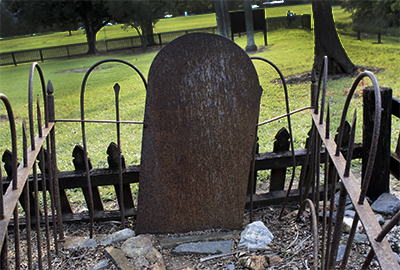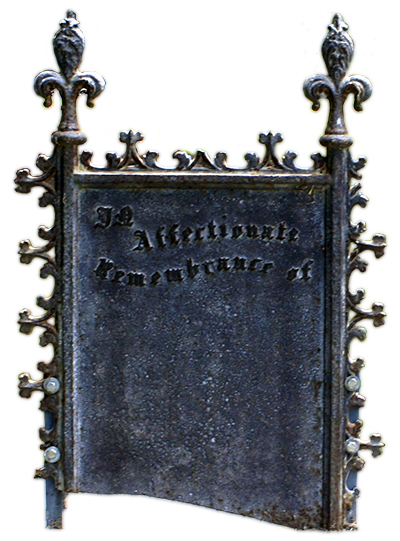Grave Marker, cast iron
Dublin Core
Title
Identifier
Description
Decorative cast-iron grave marker (a tablet or stele) which contains the embossed inscription: "In Affectionate Remembrance of".
There are no further details or identifying marks to determine whose grave it was erected over.
Creator
Subject
Cairns (NE Qld SE55-02);
Cast-iron;
Cemeteries--Australia;
Colonisation;
Frontier and pioneer life -- Australia -- Cairns Region (Qld.);
Grave Stones;
Grave Marker;
Pioneers -- Australia -- Cairns Region (Qld.) -- History;
Queensland -- Cairns Region.
Stele (Archaeology).
Date
Source
Iron grave markers and decorations were popular during the Victorian era in the United Kingdom and Australia. They were produced by specialist foundries or the local blacksmith.
This type of cast iron grave marker was designed in the 1870s by Melbourne artist and author Emily Sophia Patton. She patented this particular design in August 1876, and the tablets were manufactured by Thomas Nathaniel Tarver’s Vulcan Foundry in Sandridge.1 They cost around £4, which was 30% cheaper than stone grave markers, and the iron markers were claimed to be more durable than the ordinary class of tombstones.2
Ironmonger Alfred Shaw & Co. Ltd. of Queen Street, Brisbane was a major Queensland supplier and they advertised these tablets as being particularly suitable for transmission ‘up country’.3 The tablet would have been shipped to regional and remote areas and the name and details of the deceased would have been painted or engraved onto the face of the tablet.
The Smithfield tablet is damaged, with the left-hand corner broken and the bottom section missing. It would have originally been mounted on two triangular feet at the head of a grave (see Figure 83), but at some stage it has been broken and at least one of the triangular feet has been uprooted from the grave and left on the surface.
The tablet and one of the triangular feet were found leaning against the iron fence surrounding the marked grave when the unkempt growth of Allamanda vine was trimmed back in 2000.4 Cairns Regional Council treated the broken tablet with Plus Rust Converter and PrimerTM and then mounted it on a concrete plinth near the marked grave. The whereabouts of the uprooted triangular mounting foot is unknown. The concrete plinth does not mark a known grave.
If this tablet originally marked one of the three graves identified by surveyor Behan in 1883, then it belongs to one of the 12 burials that occurred while the township of Smithfield was in existence. However, if Maxwell Stewart’s claim that he saw the name ‘Kopp’ freshly painted on a grave stone refers to this tablet, then it marked the resting place for Smithfield milkman and dairy farmer Louis Kopp, who lived at Smithfield from its establishment in 1876 until his death in 1893, when he was buried at Smithfield cemetery.5
-
1. The triangular legs found in Smithfield Cemetery were inscribed ‘E.S. Patton’s Patent, August 30, 1876’, see van Grieken, Smithfield Cemetery and Michael Dwyer’s Grave at Stratford, 34. ↩
-
2. See photographs 16 and 17 in van Grieken, Smithfield Cemetery and Michael Dwyer’s Grave at Stratford; Advertising: R. Venables Foundry and Engineering Works, Molong Express and Western District Advertiser, 11 February 1888: 4. ↩
-
3. Classified Advertising: A. Shaw & Co. Tombstones, Queenslander, 19 October 1878: 80. ↩
-
4. van Grieken, Smithfield Cemetery and Michael Dwyer’s Grave at Stratford: 30-31. ↩
-
5. Max Stewart, one of James Stewart’s grandsons, ‘remembers that the name Louis Kopp was freshly painted on the grave stone / marker on the only grave standing in Smithfield Cemetery’, see: Smithfield Cemetery and stray burials file, CDFHS. ↩
Publisher
Format
Material: cast iron
Size: 750 mm tall x 350 mm wide.
Type
Coverage
165152S1454136E
Smithfield Cemetery, Stewarts Road, Barron, QLD 4871
Old Smithfield township, Barron QLD 4871
Colonial Queensland
1870s
Rights
Relation
Grave Marker, wrought iron

Marked grave at Smithfield Cemetery, consisting of a badly damaged wrought-iron fence surrounding a rudimentary iron grave marker. There are no…
Geolocation
Collection
Citation (Chicago 17 Style)
Item Relations
This item is related to Grave Marker, wrought iron
Map C8.88, Smithfield Cemetery, 1878 is associated with this item


